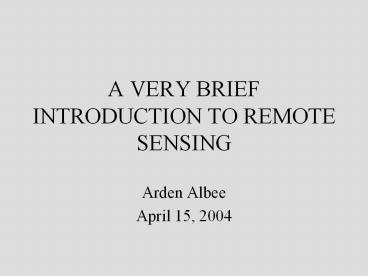A VERY BRIEF INTRODUCTION TO REMOTE SENSING - PowerPoint PPT Presentation
1 / 45
Title:
A VERY BRIEF INTRODUCTION TO REMOTE SENSING
Description:
A VERY BRIEF INTRODUCTION TO REMOTE SENSING Arden Albee April 15, 2004 ATMOSPHERIC INTERACTIONS WITH SURFACE RADIANCE Film Cameras Black & White (& later color film ... – PowerPoint PPT presentation
Number of Views:114
Avg rating:3.0/5.0
Title: A VERY BRIEF INTRODUCTION TO REMOTE SENSING
1
A VERY BRIEF INTRODUCTION TO REMOTE SENSING
- Arden Albee
- April 15, 2004
2
(No Transcript)
3
THE ELECTROMAGNETIC SPECTRUM
4
(No Transcript)
5
(No Transcript)
6
(No Transcript)
7
Modes of EM wave interaction with a surface or
media
8
SOLAR RADATION ON THE EARTHS SURFACE
9
Atmospheric absorption and useful regions for
remote sensing
10
ATMOSPHERIC INTERACTIONSWITH SURFACE RADIANCE
Murchie et al, 2000
11
Film Cameras
- Black White ( later color film) provides a
simple sensor. - Two dimensions of near-infinite, well-calibrated
pixels. Radial lines from center point of aerial
photos preserve angular relationship regardless
of topography and aircraft tilt and provide a
basis for building mosaics and geodetic nets.
Stereo images provide a basis for calculating
topography. - The Lunar Surveyor mission scanned film on board
to digitize it, whereas the later Mars Viking
mission used vidicons, essentially TV tubes in
reverse. Most of Viking analysis was done on
photo printsnot digitally. Digitization of the
prints is recent. - Point, line, and 2-D sensors became successively
available and were used in conjunction with
filters and spectrometers to build up the
capability for hyperspectral imaging.
12
Scanning approaches for use of point sensor and
line array
13
(No Transcript)
14
(No Transcript)
15
(No Transcript)
16
Hyperspectral Image Cube
17
(No Transcript)
18
Organization of hyperspectral image cube.
Geographic Information Systems (GIS) can be
regarded as an logical extension with the
additional of topographic, geographic, and
demographic data layers. Off-the-shelf systems
are available to easily manipulate such systems
whether terrestrial or martian.
19
(No Transcript)
20
CHARACTERISTIC IR SPECTRA OF ATMOSPHERE
Basic blackbody curves vary with temperature.
Absorption by gas, ice, dust, etc. provide
spectral information on the radiating material.
Note that Phobos radiation is almost pure black
body.
Christensen, et al
21
(No Transcript)
22
Decorrelation stretching for highly-correlated
data
23
(No Transcript)
24
Foreshortening
Layover
Red black indicate shadowed area
25
(No Transcript)
26
(No Transcript)
27
(No Transcript)
28
Sources of Widespread Coverage
- LandsatThematic Mapper6 vis-swir, 1 tir
- ASTER (Advanced Spaceborne Thermal Emission and
Reflection Radiometer)14 vnir-swir-tir - SRTMShuttle Radar Topographic Mission 30 m
resolution - ARCVIEWwidely used GIS software
29
(No Transcript)
30
(No Transcript)
31
Some Nuclear Physics
- Incoming cosmic rays excite Neutrons
- High energy Neutrons collide with atoms,
releasing gamma rays for specific elements - Neutrons are slowed by collusion with H to
epi-thermal (intermediate) and thermal (low)
energies - We can measure all of these from orbit and
obtain chemical composition
(GRS Science Team)
32
REVIEW OF SPECTROSCOPIC DATA (L. SODERBLOM, in
MARS, 1992)
- Spectroscopic observations cover 0.3-50 µm, but
Earth and Mars atmospheric interferences hamper
accurate mineral identification. - Water absorption at 3 µm is evident and is
spatially variable on Mars actual nature of
water is not clear - C02 ice (1.2-2.4 µm) is evident near south cap
- Multicolor images show three discrete albedo
units. - Reddish, very fine-grained, ferric oxide evident
in VIS-NIR spectra of light and dark regions Ca
pyroxene probable in dark regions - Sheet silicates, palagonite, amorphous material,
carbonate, sulphate inferred from lander
chemistry, spectral character, and theory, but
not confirmed - CONCEPT OF HIGHLY OXIDIZED AND HYDRATED WEATHERED
SURFACE PREVAILED
33
COMBINED ISM-TES SPECTRAOF SOILS
Mustard Cooper, 2002
34
COMBINED ISM-TES SPECTRAOF DARK REGIONS
Mustard Cooper, 2002
35
Typical TES spectra from Mars
36
- CONCLUSIONS
- The most distinctive geologic units on Mars are
still the light red, dark red, and dark
units and they do not match the topographic units
such as volcanic constructs. - Easily-weathered igneous minerals (feldspar,
pyroxene, and olivine) dominate dust-free
regions. Meaning of andesite is not yet clear. - Lack of significant chemical weathering of the
Martian surface indicates a geologic history
dominated by a cold, dry climate. - Similar minerals, but different proportions, as
Martian meteorites plagioclase Ca-pyroxene
dominate surface. No specific source area for
meteorites can be identified. - Widespread light-toned, cliff-forming, layered
outcrops ( sedimentary rocks) have
non-diagnostic spectra like dust.
37
(No Transcript)
38
(No Transcript)
39
(No Transcript)
40
(No Transcript)
41
(No Transcript)
42
(No Transcript)
43
(No Transcript)
44
(No Transcript)
45
(No Transcript)































